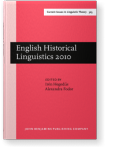The origins of how come and what…for
The multi-word items how come and what…for can both mean ‘why’ in modern English. Semantically they derive via the conceptual links ‘causes are temporally prior’, ‘causation is forced movement’, and ‘causes are purposes.’ What…for has the longer history of the two forms, going back to at least Middle English and evolving from for what via clauses with stranded preposition to a new uninterrupted form what for. How come cannot be traced back beyond the 18th century, but has various Early Modern English precursors, which may have influenced it. Its modern irregular form is most likely due to its fusion in nonstandard spoken English. The processes of semanticisation, lexicalisation and colloquialisation have played a role in the development of these forms, the latter in particular for their increasing frequency in modern standard English.
Cited by (2)
Cited by two other publications
Okrent, Arika & Sean O'Neill
2021.
Highly Irregular,

Rohdenburg, Günter
2021.
Ambiguity Avoidance by Means of Function Words in English? Providing Additional Corpus-based Counterevidence.
Zeitschrift für Anglistik und Amerikanistik 69:3
► pp. 207 ff.

This list is based on CrossRef data as of 13 july 2024. Please note that it may not be complete. Sources presented here have been supplied by the respective publishers.
Any errors therein should be reported to them.
